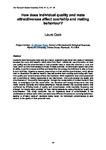How does individual quality and mate attractiveness affect courtship and mating behaviour?
| dc.contributor.author | Cook, L. | |
| dc.date.accessioned | 2019-05-21T09:07:41Z | |
| dc.date.available | 2019-05-21T09:07:41Z | |
| dc.date.issued | 2018 | |
| dc.identifier.citation |
Cook, L. (2018) 'How does individual quality and mate attractiveness affect courtship and mating behaviour?', The Plymouth Student Scientist, 11(1), p. 24-38. | en_US |
| dc.identifier.issn | 1754-2383 | |
| dc.identifier.uri | http://hdl.handle.net/10026.1/14172 | |
| dc.description.abstract |
Courtship and mating are costly and as a result, organisms are faced with trade-off decisions between the costs and benefits which arise from them. Individuals use information on their own quality and the attractiveness of their potential mate to determine whether to court and mate, and if so how much energy to invest in these activities. An individual’s quality can affect its ability to perform sexual activities and determine the energy the individual is able to invest in such activities. Organisms assess one another on their relative attractiveness, which allows them to determine the relative benefits they will receive from courting and mating with them. How quality and attractiveness affects the decisions which organisms face when presented with a courtship or mating opportunity is not fully known. This study altered the quality and attractiveness of Drosophila melanogaster, through the manipulation of nutrient levels in their diets, to investigate how this would affect the decisions and energy investments that they made towards courtship and mating behaviours. Results showed that courtship latency was unaffected by differing levels of quality and attractiveness, while courtship frequency was affected. No results were provided for how mating behaviours were affected by quality and attractiveness. This study concludes that an organisms level of attractiveness is the combination of various traits which can each have different influences on courtship behaviour, leading to different trade-off decisions being faced. An individual’s attractiveness is also relative to the quality of their potential mate. | en_US |
| dc.language.iso | en | en_US |
| dc.publisher | University of Plymouth | |
| dc.rights | Attribution 3.0 United States | * |
| dc.rights.uri | http://creativecommons.org/licenses/by/3.0/us/ | * |
| dc.subject | Courtship and mating | en_US |
| dc.subject | mate attractiveness | en_US |
| dc.subject | mating behaviour | en_US |
| dc.subject | sexual activities | en_US |
| dc.subject | Drosophila melanogaster | en_US |
| dc.subject | individual attractiveness | en_US |
| dc.subject | potential mate | en_US |
| dc.title | How does individual quality and mate attractiveness affect courtship and mating behaviour? | en_US |
| dc.type | Article | |
| plymouth.issue | 1 | |
| plymouth.volume | 11 | |
| plymouth.journal | The Plymouth Student Scientist |



